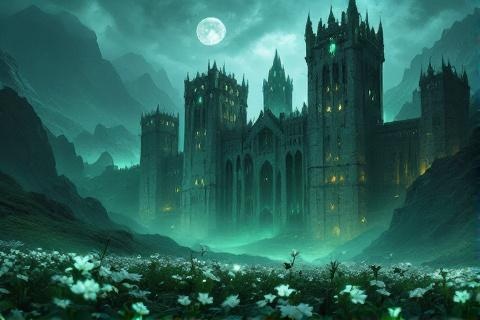
Minas Morgul: The Tower of Sorcery and Shadow
From Moonlit Beauty to the Citadel of the Witch-king
Origins as Minas Ithil: The Tower of the Moon

Minas Ithil, the Tower of the Moon, was established in the
Second Age by Isildur, son of Elendil, shortly after the
Númenóreans arrived in Middle-earth.
The fortress city was strategically positioned in a valley of the Mountains of
Shadow on the border of Mordor, serving as a vigilant outpost
against the dark land where Sauron had previously ruled.
Isildur personally oversaw its construction, designing it not only as a military
stronghold but also as a symbol of the enduring strength and vigilance of the
newly founded realm of Gondor. The fortress stood as a defiant
statement that the Men of the West would remain ever watchful against the return
of darkness to Middle-earth.
The most striking feature of Minas Ithil was its gleaming white walls and towers
crafted from marble quarried from the Mountains of Shadow. These structures were
designed with remarkable architectural skill to catch and reflect the light of
the moon, causing the entire city to shimmer with a silvery radiance when
darkness fell. On nights when the moon was full, travelers reported that the
city glowed as if crafted from moonlight itself, visible for miles across the
plains of Ithilien. This luminous quality was not merely aesthetic but also
symbolic, representing the light of wisdom and civilization shining against the
darkness of Mordor.
Within the highest tower of Minas Ithil resided one of the seven seeing stones
of Middle-earth, the Ithil-stone. This palantír was among
the most powerful artifacts brought from Númenor by Elendil
and his sons. From this chamber, the rulers of Gondor could communicate
instantaneously with those who held the other stones at Minas Anor, Orthanc, and
other strongholds of the realm. The Ithil-stone was particularly valued for its
clear view eastward, allowing Gondor's sentinels to keep watch over the empty
plains of Mordor and provide early warning should evil stir there again.
The fortress city was not merely a military installation but also a place of
great beauty. Its courtyards and terraces featured elaborate gardens filled with
white night-blooming flowers that glowed softly in the moonlight. Species like
the Ithildin, named after the city itself, opened only under starlight and
moonlight, creating paths of gentle luminescence throughout the gardens. These
blooms were cultivated by master gardeners brought from Númenor and represented
the highest horticultural arts of the Men of the West. Scented fountains played
in marble basins, and trees imported from far regions of Middle-earth provided
shade during the day and framed the moonlit vistas at night.
The Fall to Darkness
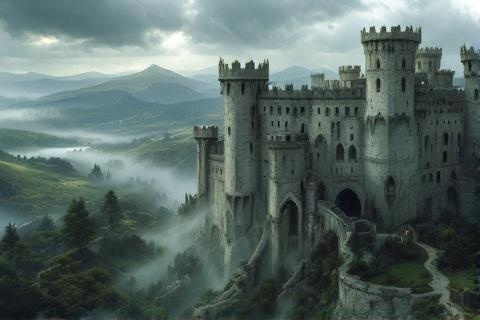
The doom of Minas Ithil came in the year 2002 of the Third Age, when the Nine
Ringwraiths, led by their terrible captain the Witch-king, laid siege to the
city. After resisting for two long years, the defenders of the fortress finally
succumbed to hunger, fear, and the dark sorceries of the Nazgûl.
The fall of the Tower of the Moon marked one of the greatest tragedies in the
history of Gondor, as the kingdom lost not only a strategic military position
but also one of its most beautiful cities. Many of the garrison fought to the
death rather than surrender, while those citizens who could not escape were
either slain or enslaved by the servants of the Enemy.
Perhaps the most devastating loss in the fall of Minas Ithil was the capture of
the Ithil-stone by the forces of Sauron. This powerful palantír was taken to
Barad-dûr, where the Dark Lord himself could use it to corrupt the visions seen
in the other stones and spy upon his enemies. Through the captured seeing stone,
Sauron could project false visions to mislead those who dared use the remaining
palantíri, as later happened to Saruman and even Denethor, the last ruling
Steward of Gondor. The loss of the stone also meant that Gondor's ability to
monitor the movements within Mordor was severely compromised, allowing Sauron to
rebuild his forces in greater secrecy.
Over the centuries following its capture, Minas Ithil underwent a horrifying
transformation, becoming known as Minas Morgul, the Tower of Black Sorcery. What
had once been a beacon of light and hope gradually became a wellspring of terror
and corruption. The very stones of the city seemed to absorb the malice of their
new masters, while dark enchantments worked upon them twisted their nature. The
gardens withered and were replaced with poisonous growths, the clear waters
became foul, and the once-beautiful architecture was perverted into forms that
inspired fear rather than awe. Even the air around the fortress became heavy
with dread, and tales spread throughout Gondor of travelers who merely glimpsed
the city from afar and were haunted by nightmares for the rest of their lives.
Architecture of Dread
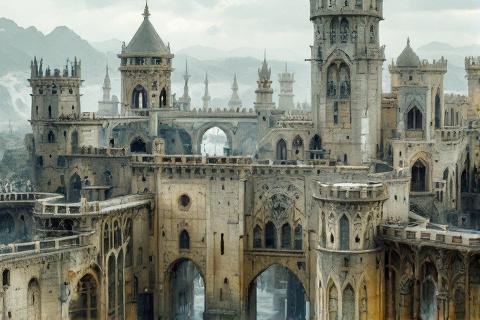
The most visible sign of Minas Morgul's corruption was the ghastly
transformation of its once-white marble. Where the stonework had previously
reflected the pure light of the moon with a silvery radiance, it now emanated an
unnatural, sickly glow that resembled the phosphorescence of decaying matter.
This pale, greenish luminescence seemed to pulse with a life of its own, growing
stronger and weaker in rhythm like the breathing of some vast, malevolent
organism. The light cast no true illumination but rather seemed to deepen the
shadows around it, creating a disorienting effect that confused and terrified
any who approached. According to accounts in the Red Book of Westmarch, Frodo
Baggins described the light as a dead and pallid gleam, like a corpse-light.
The walls and gates of Minas Morgul became adorned with grotesque sculptures and
corrupted emblems that mocked the original Gondorian artistry. Where noble kings
and heroes had once stood in marble effigy, now hunched and twisted forms leered
down at travelers. The White Tree emblem of
Gondor was replaced with obscene parodies showing withered and blighted trees
bearing fruit shaped like skulls. Gargoyles resembling tortured souls peered
from every corner and battlement, their faces frozen in silent screams. The main
gate, once decorated with symbols of the moon and stars, now featured carvings
of hideous creatures unknown in the natural world, their forms suggesting a
merging of men, beasts, and insects into nightmare combinations.
The central tower of Minas Morgul rose far higher than in its original design,
stretched and distorted by dark sorcery until it seemed impossibly tall and
thin. What had once been a graceful spire now resembled a terrible spike thrust
into the sky, its proportions defying the normal laws of stone and balance.
Windows that had once been regular and harmonious were now misshapen apertures
that glowed with that same unhealthy light, resembling watchful eyes gazing out
across the lands. The tower's pinnacle was crowned with a constantly rotating
beacon that cast its ghastly illumination across the valley, serving both as a
signal to the servants of Mordor and as a source of dread for any who saw it
from afar.
The entire infrastructure of Minas Morgul was rebuilt to accommodate the Nazgûl
and their terrible steeds. Broad bridges strong enough to bear the weight of the
fell beasts replaced the delicate spans that had once connected the city's
towers. New passages large enough for the winged creatures to pass through were
carved into the mountainside, allowing the Ringwraiths to come and go unseen
when necessary. Specialized roosting chambers were constructed high in the upper
reaches of the fortress, where the creatures could rest between their terrible
missions across Middle-earth. The once-narrow streets were widened and
redesigned with strange, asymmetrical patterns that had no practical purpose for
human inhabitants but seemed to follow some alien logic comprehensible only to
the Nazgûl themselves.
Within the walls of Minas Morgul, halls that had once housed libraries, council
chambers, and living quarters for the soldiers and citizens of Gondor were
transformed beyond recognition. Libraries where lore had been preserved became
chambers where forbidden knowledge was studied and dark incantations developed.
The great hall where Isildur had once held court became the throne room of the
Witch-king, draped in black banners bearing the symbols of Mordor. Former living
quarters were converted into torture chambers where captives were subjected to
both physical torments and the mind-breaking presence of the Ringwraiths. The
deepest levels, once storage areas and foundations, were expanded into vast
underground complexes where the most terrible experiments and rituals took
place.
The Valley of the Wraiths

The valley leading to Minas Morgul, once a fertile and beautiful approach to the
Tower of the Moon, suffered corruption equal to the city itself. Known as the
Morgul Vale, this once-verdant area became a place of dread and unwholesomeness.
The natural features of the landscape seemed warped, with trees growing in
twisted shapes and rocks taking on forms that suggested faces in agony. A
perpetual mist hung over the lower portions of the valley, obscuring visibility
and causing disorientation in travelers who dared venture there. This fog was
said to be not merely natural but a manifestation of the evil will that ruled in
Minas Morgul, an extension of the Nazgûl's influence reaching out beyond the
city walls.
Throughout the Morgul Vale grew fields of pale white flowers, a corrupt mockery
of the beautiful blooms that had once graced the gardens of Minas Ithil. These
phosphorescent blooms gave off a sickly sweet scent like that of decaying flesh,
which could cause dizziness and hallucinations in those who breathed it for too
long. According to the accounts of Frodo Baggins and Samwise Gamgee, who passed
through the vale on their journey to Mordor, the flowers seemed to glow with the
same corpse-light as the city itself. Botanical scholars of Gondor later
theorized that these plants were not natural growths but manifestations of the
corruption spreading from Minas Morgul, possibly cultivated deliberately by the
servants of the Witch-king for their poisonous and disorienting properties.
Through the center of the valley flowed the Morgulduin, or River of Sorcery,
whose waters ran cold and seemed almost luminous with the same pale light that
emanated from the city. This river, once a clear tributary of the Anduin, became
tainted shortly after the Nazgûl took the city. Its waters were said to induce
terrible visions in those who drank from them or even touched them without
protection. Vapors rising from the river contributed to the unnatural mists that
shrouded the valley. Small, eyeless fish could sometimes be seen swimming in its
depths, their flesh as white as the stone of the city and reportedly poisonous
to eat. The Morgulduin served as both a physical and symbolic boundary, marking
the point beyond which the influence of Minas Morgul was at its strongest.
Perhaps the most unnerving aspect of the Morgul Vale was the almost complete
absence of natural life. No birds sang in the twisted trees, no small animals
rustled in the underbrush, and even insects avoided the area when possible. The
only creatures that willingly dwelled there were those directly in service to
the Witch-king: orcs patrolling the approaches to the city,
carrion birds circling above, and occasionally the fell beasts of the Nazgûl
when they were not abroad on some evil errand. Plants grew in abundance but
showed signs of corruption, with pale leaves and stems that seemed to turn
toward Minas Morgul as if drawn by its power rather than the sun. This unnatural
silence created a profound psychological effect on any who entered the vale.
Seat of the Witch-king

From the corrupted towers of Minas Morgul, the Lord of the Nazgûl established
his dominion over eastern Gondor. Once a great king of men in the northern
realms, he had fallen under the power of the Ring he
received from Sauron and over centuries transformed into the most terrible of
the Ringwraiths. Known as the Witch-king of Angmar for his earlier conquests in
the north, he brought to Minas Morgul both military strategy and dark magical
knowledge unmatched among Sauron's servants. His presence alone could cause
brave men to flee in terror, and his shriek could freeze the blood of even the
most stalwart warrior. The Witch-king ruled Minas Morgul not through councils or
governance but through absolute fear and the terrible will he imposed on all
within his domain.
Minas Morgul served as the primary gathering place for all nine Nazgûl when they
returned to Middle-earth after their defeat in the floods of the River Bruinen.
Though they would often travel far on Sauron's business, they would return to
the dread city to report, plan, and recover their strength. Each of the Nine had
personal chambers within the fortress, areas so saturated with their malevolent
presence that even orcs would not enter unless specifically commanded. When all
nine were present in Minas Morgul, the dread emanating from the city was said to
be palpable for miles around, causing nightmares in the sleep of people as far
away as Osgiliath. The Nazgûl would gather in council in what had once been the
central hall of the fortress, their whispered communications incomprehensible to
mortal ears but carrying terrible purpose and malice.
In bitter irony, the Witch-king established his throne room in what had once
been Isildur's personal chambers at the heart of the fortress. The room where
the founder of Minas Ithil had planned the defenses of Gondor became the chamber
where strategies against that very kingdom were devised. The Witch-king's throne
was carved from a single piece of black stone said to have been brought from the
foundations of Barad-dûr itself. This seat radiated a cold so intense that frost
formed on nearby surfaces even in summer. Behind the throne hung tattered
banners taken from defeated Gondorian companies, and around the walls were
displayed weapons and armor from fallen champions of the west, each a trophy
representing a victory against the enemies of Mordor.
The dark rituals practiced within the walls of Minas Morgul gave the city its
fearsome new name, the Tower of Sorcery. Under the direction of the Witch-king,
who had studied forbidden arts for over a millennium, the Nazgûl and their
servants conducted terrible magical workings that corrupted not just the
physical structure but the very fabric of reality around the fortress. Blood
sacrifices were common, with captives from Gondor and other lands brought to
secret chambers deep within the mountain. The purpose of these rituals varied,
from strengthening the power of the Nazgûl to creating new weapons and poisons,
to divining the movements of enemies across Middle-earth. During particularly
potent ceremonies, witnesses from as far away as Ithilien reported seeing
unnatural lights above the city.
Dark Powers and Sorceries

The dark magics practiced in Minas Morgul were varied and terrible, earning the
fortress its reputation as a center of black sorcery. The Nazgûl, drawing on
knowledge from both Sauron's teachings and their own centuries of existence,
developed spells of fear, domination, and destruction that far exceeded the
capabilities of mortal sorcerers. Weather-working was among their arts, allowing
them to call down unnatural storms or create the foul mists that shrouded their
domain. Divination through dark means gave them insights into events happening
far away, complementing the information gathered through the captured
Ithil-stone. They were also masters of what the loremasters called shadow-craft,
the ability to deepen natural darkness and infuse it with malevolent purpose, as
demonstrated when they sent darkness ahead of the armies of Mordor during the
Siege of Gondor.
Among the most dreaded magical creations of Minas Morgul were the morgul-spells
that could enslave the will and transform living beings. These enchantments,
often delivered through cursed weapons like the morgul-knife that struck Frodo
Baggins, would gradually convert a victim into a wraith under the dominion of
the Nazgûl. The process began with physical symptoms of coldness and pain before
progressing to spiritual corruption as the victim's soul was drawn increasingly
into the unseen realm where the Ringwraiths had their true power. If not treated
by masters of healing like Elrond of Rivendell, victims would eventually become
entirely subservient to the will of the Witch-king, visible spectral servants
trapped between life and death.
Perhaps the most pervasive magical effect emanating from Minas Morgul was the
overwhelming aura of terror that surrounded it. This was not merely the natural
fear that might be felt when approaching an enemy stronghold but a supernatural
dread that could paralyze the will and cloud the mind. The effect was strongest
close to the city but extended miles into the surrounding lands, creating a
buffer zone that few would willingly enter. This aura was not constant but waxed
and waned with purpose, growing stronger when the Nazgûl wished to remain
undisturbed or when they were conducting particularly powerful rituals. At its
height, the fear could cause physical symptoms in those who experienced it: cold
sweats, trembling, disorientation, and in extreme cases, temporary blindness or
paralysis.
According to accounts from those who survived encounters near Minas Morgul, the
very stones of the fortress seemed to be imbued with malice and awareness. Walls
appeared to shift subtly when not directly observed, passages would seem longer
or shorter on different journeys, and throughout the structure, visitors felt
the unsettling sensation of being watched by countless hidden eyes. This
apparent sentience was not merely superstitious imagination but the result of
specific enchantments laid upon the fortress by the Nazgûl over centuries of
occupation. Using techniques learned from Sauron, who had imbued the foundations
of Barad-dûr with his own will, the Witch-king worked spells that allowed the
physical structure of Minas Morgul to serve as an extension of the awareness of
its masters.
Sentinels and Guardians
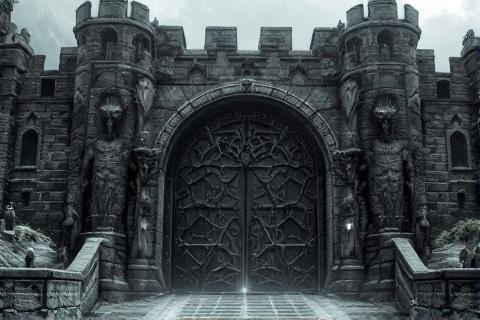
The defenses of Minas Morgul extended far beyond mere physical fortifications,
incorporating layers of supernatural protection that made it one of the most
secure strongholds in Middle-earth. Invisible barriers of force surrounded the
outer walls, detectable only when they repelled certain types of weapons or
magic. Enchantments confounded the minds of those approaching with hostile
intent, causing them to make poor decisions or even turn against their
companions. The very air around the fortress was imbued with properties that
could detect the presence of powerful magical items like the One
Ring, which nearly revealed Frodo Baggins when he passed
nearby. Most insidious were the magical wards that could attach themselves to
unwary intruders who managed to escape, allowing the Nazgûl to track them across
great distances or send dreams to torment them long after they had fled the
valley.
Guarding the main gate of Minas Morgul were the dreadful entities known as the
Two Watchers, described in Frodo's account as seated figures with three joined
bodies and vulture-like heads. These were not living creatures but magical
constructs, similar in nature to the Watchers later encountered at the Tower of
Cirith Ungol but far more powerful. Created through
ancient sorcery that may have predated even the Nazgûl's occupation, these
guardians could detect the presence and intentions of any who approached the
gate. Their power manifested as an invisible barrier that could not be passed
without the proper words of command known only to the servants of Mordor. Those
who attempted to force passage without authorization would find themselves
paralyzed by the mental assault of the Watchers.
The visible military presence in Minas Morgul consisted primarily of orcs and
evil Men, though in smaller numbers than might be expected for such an important
fortress. These troops were not the main defensive force but rather served as
messengers, laborers, and handlers of routine matters that did not require the
direct attention of the Nazgûl. The orcs of Minas Morgul were distinctive in
appearance, typically taller and more disciplined than their mountain
counterparts, with pale skin and eyes adapted to the perpetual twilight of their
home. They wore armor bearing the emblem of the moon defaced with a hideous
death's head. The Men who served in Minas Morgul came from various eastern and
southern realms, many being descendants of Númenórean colonists who had fallen
under the Shadow in ages past.
In the deepest dungeons and caverns beneath Minas Morgul dwelled creatures that
rarely saw the light of day, horrors kept even from the knowledge of most who
served the fortress above. Some were results of the Nazgûl's cruel experiments,
beings that had once been human or animal but had been twisted through dark
magic into forms that no longer resembled their origins. Others were ancient
entities drawn from the dark places of the world by the power concentrated in
Minas Morgul, creatures that predated even the rise of Sauron and served the
Witch-king out of alignment of purpose rather than fear or obedience. Tales told
by escaped prisoners spoke of things that slithered through tight passages in
the deepest levels, of voices that whispered madness, and of chambers where the
laws of nature seemed suspended.
Weapons and War

The armories of Minas Morgul contained weapons both conventional and magical,
making its soldiers among the most dangerous in Sauron's service. Standard arms
included curved swords similar to those used by the Haradrim, spears tipped with
barbed heads designed to create grievous wounds, and crossbows whose bolts were
often poisoned to ensure that even minor injuries could prove fatal. More
fearsome were the enchanted weapons reserved for elite warriors or special
missions, blades that could cut through normal armor with unnatural ease or
maces that shattered bone on impact regardless of the strength behind the blow.
Many of these weapons bore curses that caused wounds inflicted by them to resist
healing or spread corruption through the victim's body. The most valuable and
dangerous items were kept in special vaults accessible only to the Nazgûl
themselves.
Among the most dreaded weapons in Minas Morgul's arsenal were the morgul-knives,
slender blades imbued with powerful enchantments designed to corrupt rather than
kill outright. These weapons appeared almost insubstantial, with blades so thin
they were nearly transparent when viewed from certain angles, yet they could
pierce even the strongest armor with unnatural ease. The true danger lay not in
the physical wound but in the shard of the blade designed to break off inside
the victim and work its way toward the heart, carrying with it the morgul-spell
that would transform the wounded person into a wraith. Frodo Baggins experienced
this firsthand when wounded by the Witch-king on Weathertop, and only the
extraordinary healing skills of Elrond prevented his complete conversion.
Beyond its supernatural significance, Minas Morgul served as a critical military
installation controlling access to Mordor from the west. The fortress was
positioned to monitor the pass of Cirith Ungol and block any attempted invasion
through the Mountains of Shadow, while simultaneously providing a launching
point for raids into Ithilien and beyond. The garrison maintained a network of
outposts and patrol routes throughout the surrounding regions, gathering
intelligence on Gondorian movements and maintaining pressure on their eastern
borders. Military planning rooms contained detailed maps of Gondor's defenses,
updated regularly by spies and scouts, allowing the Witch-king to identify
weaknesses that could be exploited. As the War of the Ring approached, Minas
Morgul became the assembly point for a significant portion of Sauron's western
forces.
During times of war or when preparing for major military operations, the
characteristic pale glow of Minas Morgul would change to a pulsing red light
that could be seen for miles around. This transformation served multiple
purposes, both practical and psychological. For Sauron's forces, it was a
rallying signal, indicating that the time for action had come and drawing troops
from outlying areas to assemble at the fortress. For the enemies of Mordor, it
served as a terror tactic, a visible manifestation of the threat gathering
against them. The red illumination was not merely a different color but carried
with it an intensification of the dread aura that normally surrounded the city,
causing even greater fear and confusion among those who witnessed it.
The Silent Streets
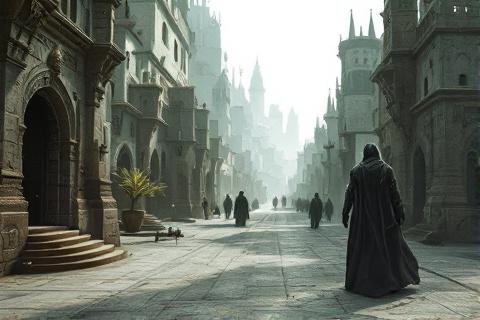
The streets of Minas Morgul presented an eerie contrast to the bustling
thoroughfares they had once been during the days of Gondorian rule. Where
merchants, soldiers, and citizens had once gone about their daily business, now
only occasional patrols of orcs or enslaved humans moved through the twisted
passages. The city was maintained at a far lower population than its capacity
would allow, with many buildings standing empty for centuries, their doors
sealed with strange symbols warning even the servants of the Nazgûl to stay
away. This emptiness served a practical purpose, as the Ringwraiths preferred
isolation and had little need for the infrastructure that supported normal urban
life. It also created a psychological effect, with the vacant streets and silent
buildings contributing to the unsettling atmosphere that pervaded the entire
fortress.
Though many structures in Minas Morgul stood empty, others were repurposed for
the needs of its new masters in ways that perverted their original functions.
What had once been temples dedicated to the Valar became chambers
for dark rituals honoring Sauron and even older, nameless powers from the void.
Markets where goods had been traded were converted into processing areas where
tribute from subjugated lands was sorted and distributed. Homes that had housed
families became barracks for orcs or quarters for human slaves who performed
necessary maintenance tasks. The great library, once a repository of Gondorian
knowledge and lore, became an archive of forbidden knowledge where the Nazgûl
collected texts on sorcery, poisons, and ancient evils from across Middle-earth.
Visitors to Minas Morgul often remarked on the unnatural cleanliness of its
streets and public spaces, a quality that made the corruption of the city all
the more disturbing. No dust gathered on surfaces, no debris collected in
corners, and even the continuous drip of moisture from the cavern ceilings left
no stains or puddles. This supernatural cleanliness was not the result of
diligent maintenance but another manifestation of the dark enchantments that
permeated the fortress. Some scholars theorized that the same power that gave
the stones their corpse-light glow also repelled natural processes of decay and
accumulation, creating an environment of preserved corruption rather than
ongoing deterioration. The clean streets stood in sharp contrast to the moral
filth that pervaded the activities within Minas Morgul.
Minas Morgul lacked all the normal functions that defined a living city. No
markets existed where goods could be traded, as all supplies came directly from
Mordor or were taken as tribute from subjugated regions. No artisans practiced
their crafts except those directly serving military needs, such as weaponsmiths
and armorers. No governance occurred beyond the absolute rule of the Nazgûl and
their appointed lieutenants, with no councils, courts, or civic institutions to
manage daily affairs. There were no celebrations or festivals, no communal
meals, and no gatherings except those specifically ordered for military purposes
or dark rituals. This absence of normal urban activity reflected the fundamental
nature of Minas Morgul – it was not truly a city but a military installation and
focal point for dark power.
Echoes of Gondor: What Remained
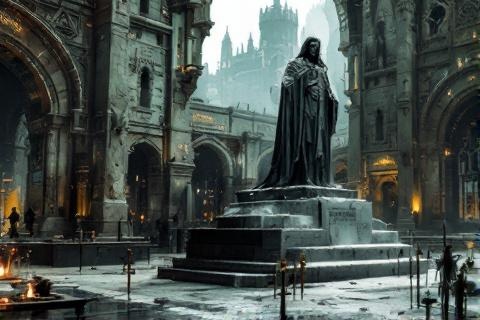
Despite centuries of corruption and alteration, keen observers could still
identify elements of the original Gondorian architecture throughout Minas
Morgul. The fundamental layout of concentric circles rising up the mountainside
remained, though now twisted and distorted. Some of the great archways retained
their original proportions and structural elements, even if the decorations had
been defaced or replaced. The drainage and water systems, masterworks of
Númenórean engineering, continued to function largely as designed, though now
carrying tainted waters. In certain areas less frequented by the Nazgûl, more
substantial elements of the original design survived, including intact murals or
decorative stonework that had somehow escaped notice during the renovation of
the city. These remnants stood as silent witnesses to the former glory of Minas
Ithil.
Throughout Minas Morgul, ancient inscriptions and symbols of Gondor could still
be found, though often defaced or partially obscured. The highest level of
craftsmanship had gone into these original carvings, with some cut so deeply
into the stone that they could not be completely removed without destroying
structural elements. Phrases in High Númenórean celebrating the founding of the
city or commemorating victories against Sauron in the Second Age remained
visible in secluded corners. The emblem of the White Tree appeared in stylized
form in floor mosaics or ceiling patterns where it had been overlooked during
the conversion of the fortress. Most significant were the protective runes and
blessings carved into foundation stones and key structural points, placed there
by Isildur himself and the master craftsmen of early Gondor.
The basic layout created by Isildur for Minas Ithil remained largely intact
despite the transformations wrought by the Nazgûl. The seven levels rising up
the mountainside, the switchback road connecting them, and the positioning of
the main gates all followed the original design, though now serving darker
purposes. This preservation was partly practical – the Númenórean architects had
chosen the most efficient and defensible arrangement for the terrain, which
remained advantageous regardless of who held the fortress. It was also partly a
matter of dark pride, with the Witch-king maintaining the original structure as
a trophy of conquest, a constant reminder of how the greatest works of the Men
of the West had fallen under the Shadow.
The Nazgûl maintained a collection of artifacts from the days of Gondor's rule,
kept not for their beauty or utility but as trophies symbolizing their victory
over the Men of the West. These items were displayed prominently in significant
chambers throughout Minas Morgul, particularly in the throne room of the
Witch-king. They included weapons taken from fallen Gondorian champions, banners
captured in battle, and ceremonial objects from the original temples and
government buildings of Minas Ithil. Of particular importance were items
associated with Isildur himself, including personal effects left behind when the
city fell and ceremonial objects used in the founding of the fortress. These
artifacts were often incorporated into dark rituals, their connection to the
heritage of Gondor making them powerful symbolic tools for magic intended to
harm the kingdom.
The Fate of Minas Morgul
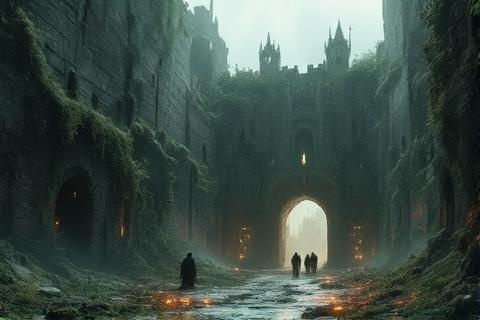
As the War of the Ring reached its climax, Minas Morgul was largely abandoned
when the Nazgûl joined Sauron's main forces for the assault on Minas Tirith. The
Witch-king led the majority of the garrison out in a great host that would
eventually clash with the defenders of Gondor on the Pelennor Fields. This
departure left the fortress nearly empty for the first time in a millennium,
with only a skeleton crew of orcs remaining to maintain essential functions. The
sudden absence of the Nazgûl's direct influence caused some of the supernatural
effects around the city to diminish, though the deep corruption built up over
centuries remained embedded in the very stones. During this period, the pale
light flickered and dimmed, and some of the magical barriers weakened enough
that scouts from Gondor were able to approach closer than had been possible for
generations.
After Sauron's defeat and the crowning of Aragorn as King
Elessar, one of the new monarch's first decrees
regarding the eastern territories concerned Minas Morgul. Recognizing that the
corruption of the fortress went far beyond physical occupation, the King ordered
that the city be left empty for seven years to allow for the dissipation of the
evil that had accumulated there. During this period, only specially trained
teams were permitted to enter the valley, working to dismantle dangerous
enchantments and remove or destroy items of power left behind by the Nazgûl.
Elven loremasters from both Rivendell and Lothlórien
provided guidance on these efforts, bringing ancient knowledge of how to counter
works of darkness. Healers and herbalists worked to cleanse the soil and waters
of the valley, introducing plants known to absorb and neutralize corruption.
Despite these extensive efforts at cleansing, it became apparent that the
corruption of Minas Morgul had penetrated too deeply to be fully reversed. After
the seven-year period of attempted purification, King Elessar made the difficult
decision to destroy the fortress completely rather than attempt to reclaim it
for Gondor. This task was undertaken with great care, as simply demolishing the
structures might have released the concentrated evil trapped within them. Master
stoneworkers and engineers from both Gondor and the Dwarven
realms collaborated to dismantle the city level by level,
beginning with the highest towers and working downward. Each stone was
individually inspected, with those deemed too corrupted for reuse being broken
and buried in deep pits with appropriate containment measures.
While the fortress itself was deemed beyond redemption, the valley in which it
stood could eventually be reclaimed. After the complete removal of all
structures associated with Minas Morgul, a comprehensive effort began to cleanse
and restore the natural environment of what had once been one of the most
beautiful approaches to Gondor. The corrupted soil was removed in layers and
replaced with clean earth brought from other regions. The Morgulduin was
temporarily dammed and its channel cleared of tainted sediment before the waters
were allowed to flow again, now blessed by Elven ceremonies that helped to
purify them as they passed. New trees were planted, chosen for their resistance
to corruption and ability to thrive in previously blighted soil. Though King
Elessar decreed that no city would be built there for many generations, small
shrines were established to honor what had once been and what might be again.
